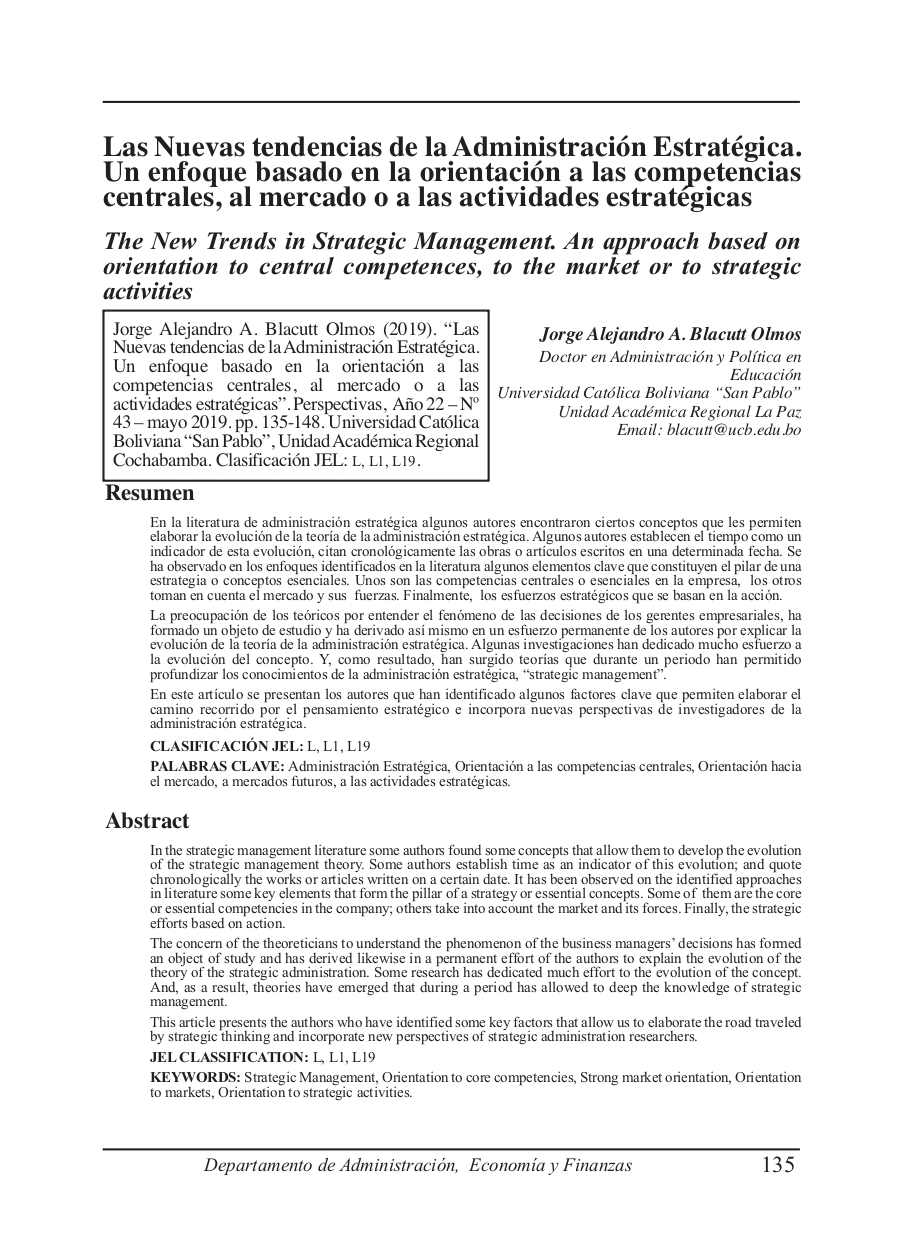The New Trends in Strategic Management. An approach based on orientation to central competences, to the market or to strategic activities
DOI:
https://doi.org/10.35319/xhhjmx35Keywords:
Strategic Management, Orientation to core competencies, Strong market orientation,, Orientation to markets, Orientation to strategic activitiesAbstract
In the strategic management literature some authors found some concepts that allow them to develop the evolution of the strategic management theory. Some authors establish time as an indicator of this evolution; and quote chronologically the works or articles written on a certain date. It has been observed on the identified approaches in literature some key elements that form the pillar of a strategy or essential concepts. Some of them are the core or essential competencies in the company; others take into account the market and its forces. Finally, the strategic efforts based on action.
The concern of the theoreticians to understand the phenomenon of the business managers’ decisions has formed an object of study and has derived likewise in a permanent effort of the authors to explain the evolution of the theory of the strategic administration. Some research has dedicated much effort to the evolution of the concept. And, as a result, theories have emerged that during a period has allowed to deep the knowledge of strategic management.
This article presents the authors who have identified some key factors that allow us to elaborate the road traveled by strategic thinking and incorporate new perspectives of strategic administration researchers.
Downloads
References
Ansoff, I., & McDonell, E. (1990). Implanting strategic management. New York: Prentice Hall.
Ansoff, I., & McDonell, E. (1997). La dirección estratégica en la práctica empresarial. México: Pearson Educación.
Barney, J. (1991). Firm resources and sustained competitive advantage. Journal of Management, 17(1), 99–120. https://doi.org/10.1177/014920639101700108
Bracker, J. (1980). The historical development of the strategic management concept. Academy of Management Review, 5(2), 219–224. https://doi.org/10.5465/amr.1980.4288881
Brown, S., & Eisenhardt, K. M. (1998). Competing on the edge: Strategy as structured chaos. Boston: Harvard Business School Press.
Brown, S., & Eisenhardt, K. M. (2002). Competir al borde del caos: Estrategias para enfrentar los cambios vertiginosos. Barcelona: Granica.
Chandler, A. D. (1962). Strategy and structure: Chapters in the history of the American industrial enterprise. Cambridge, MA: MIT Press.
Drucker, P. F. (1997). La gerencia de empresas. Buenos Aires: Sudamericana.
Glueck, W. F. (1972–1976). Business policy: Strategy formation and management action. New York: McGraw-Hill.
Hamel, G., & Prahalad, C. K. (1994). Competing for the future: Breakthrough strategies for seizing control of your industry and creating markets of tomorrow. Boston: Harvard Business School Press.
Hamel, G., & Prahalad, C. K. (1995). Compitiendo por el futuro: Estrategia crucial para crear los mercados del mañana. Barcelona: Ariel.
Kim, W. C., & Mauborgne, R. (2005). Blue ocean strategy: How to create uncontested market space and make the competition irrelevant. Boston: Harvard Business Review Press.
Kim, W. C., & Mauborgne, R. (2005). La estrategia del océano azul: Cómo desarrollar un nuevo mercado donde la competencia no tiene ninguna importancia. Bogotá: Norma.
Mintzberg, H. (1994). The rise and fall of strategic planning. New York: Free Press.
Mintzberg, H., Ahlstrand, B., & Lampel, J. (1998). Strategy safari: A guided tour through the wilds of strategic management. New York: Free Press.
Mintzberg, H., Ahlstrand, B., & Lampel, J. (2016). Safari a la estrategia. Buenos Aires: Granica.
Mintzberg, H., Quinn, J. B., & Voyer, J. (1997). El proceso estratégico: Conceptos, contextos y casos. México: Prentice Hall Hispanoamericana.
O'Shannassy, T. (1999). Lessons from the evolution of the strategy concept. RMIT Business, 1(1), 1–12.
Porter, M. E. (1979). On competition. Boston: Harvard Business Review Press.
Porter, M. E. (1999). Ser competitivo: Nuevas aportaciones y conclusiones. Bilbao: Deusto.
Prahalad, C. K., & Krishnan, M. S. (2009). La nueva era de la innovación: Cómo crear valor a través de redes globales. México: McGraw Hill.
Steiner, G. A. (1979). Strategic planning: What every manager must know. New York: Free Press.
Steiner, G. A., & Miner, J. B. (1977). Management policy and strategy. New York: Macmillan Publishing Co.
Zhexembayeva, N. (2014). La estrategia del océano esquilmado. Barcelona: Libros de Cabecera.

Downloads
Published
Issue
Section
License
Copyright (c) 2019 Revista Perspectivas

This work is licensed under a Creative Commons Attribution-NonCommercial-ShareAlike 4.0 International License.
La Revista Perspectivas de la Universidad Católica Boliviana, es una revista de acceso abierto, por lo tanto, es de libre acceso en su integridad. Está permitida su lectura, búsqueda, descarga, distribución y reutilización legal en cualquier tipo de soporte únicamente para fines no comerciales, siempre y cuando la obra sea debidamente citada.




